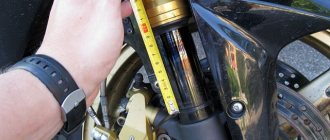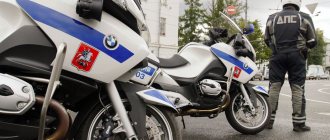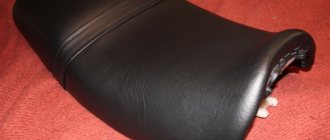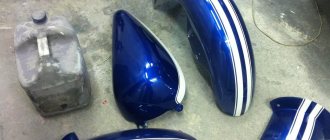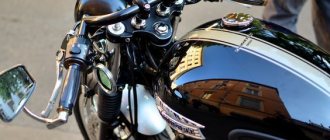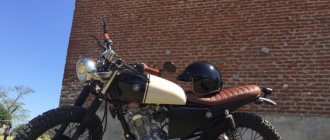Any choppers are not motorcycles for everyone . This class of motorcycles seems to be out of time, and does not lose popularity, despite its inherent archaism. Modern technologies are practically not being introduced, except for the most necessary ones, and the appearance still resembles bikes from the 60s of the last century. Indeed, why change something that is already beautiful? What is a chopper anyway? Many fans of this style will confidently answer that this is not just a class of motorcycles. It is an ideology, a lifestyle and practically a religion.
Chopper history
For the first time, bikes that can be classified in this class appeared in the USA about 60 years ago. The word “chopper” itself comes from the English verb “chop,” which means “to chop.” Does it sound strange? Not at all! It’s just that after World War II, America found itself with a huge number of demobilized soldiers, some of whom, due to the sharply jumping unemployment rate, turned to crime. Heavy Harley-Davidson motorcycles were the most affordable transport at that time, which is why the first bikers formed gangs on two wheels, regularly terrorizing local residents. And to make it easier to escape from the police, they often removed everything from their bikes except what was needed for direct movement. Such a cruiser that had undergone the “ axe treatment ” became a chopper, losing a lot of weight and thereby increasing the maximum speed available to it . Here is a basic list of changes that were usually made to the design:
- Silencers were cut or replaced with shorter ones
- The passenger seat was removed and the rear fender was often cut off
- Even mirrors and turn signals , and sometimes taillights,
- A small teardrop-shaped gas tank instead of the standard one
- was thrown out .
A typical American chopper can be seen in the movie Easy Rider. This is the bike that Peter Fonda's character Captain America rides, and it has become an inspiration for tens of thousands of customizers around the world.
Motorcycle geometry and its effect on handling
This text is for those who are interested in understanding the difference and essence of single-track vehicles. Nothing complicated, everything is within the framework of a school course in mathematics and a little physics.
First, let's get acquainted with kinematics. Kinematics does not take into account the mass of bodies and the forces acting on these bodies, but only describes their geometric properties, in contrast to dynamics. Kinematic studies of single-track vehicles are important because they help explain their dynamic behavior. For clarity, some simple examples of the dynamic behavior of motorcycles will be given here to show how kinematic features affect their stability and maneuverability.
So: the kinematic definition of a motorcycle.
Although motorcycles consist of a large number of mechanical parts, including some complex ones, from a strictly kinematic point of view, conventionally considering suspensions as rigid, a motorcycle can be simply defined as a spatial mechanism consisting of four rigid bodies:
- Rear assembly (frame, seat, tank, engine, transmission)
- Front assembly (fork, triple clamps, steering column and handlebars)
- Front wheel
- Rear wheel
These bodies are connected by three pivot joints (steering axle and two wheel axles) and are in contact with the ground at two points, which we call contact patches, as shown in the figure below
Note that the number of degrees of freedom of a motorcycle is only 3. We have 4 rigid bodies, each of which has 6 degrees of freedom (movement along the axes - 3 and rotations around the axes - 3) 6x4 = 24. Considering that there are 15 degrees of freedom, it is limited to 3- with rotary joints and 6 degrees of freedom, eliminated by 2 points of contact of the wheel with the ground. If we subtract them from the indicated 24 degrees of freedom, limited to 21, then 3 remain - forward movement, steering wheel rotation and tilt relative to the axis passing through the contact spots with the ground.
While riding, the motorcyclist operates all three degrees of freedom in accordance with his personal style and skill: the resulting movement of the motorcycle and the corresponding trajectory depend on the combination in time of the three movements associated with the three degrees of freedom. These considerations were formulated under the assumption that the tires move without slipping. However, in reality, the movement of tires is not just a rolling process. Acceleration, braking, and leaning generate longitudinal and lateral forces that lead to wheel slip, to varying degrees depending on road conditions. Accordingly, to the existing three degrees of freedom we must add four more, that is, longitudinal and transverse slipping of each of the wheels.
This kinematic study concerns a rigid motorcycle, i.e. without suspension with wheels, with non-deformable tires, and schematized as two toroidal rigid bodies with circular sections. Now directly about the geometry.
Motorcycles can be described using the following geometric parameters:
- p – wheelbase
- d - offset - the distance between the center of the front wheel and the plane in which the steering column axis lies
- ε – castor (angle of inclination of the steering column axis)
- R r – rear wheel radius
- R f – radius of the front wheel
- t r – rear tire section radius
- t f — front tire section radius
- a – mechanical trail
- a n – geometric trail
Geometric and mechanical trails can be described in the following terms:
a n = R f* sin ε – geometric or, as it is also called, normal trail. In this case, this correlates with the word “normal” - perpendicular and it is more correct to call it geometric.
a = a n* cos ε = R f* tan ε – d/ cos ε – mechanical or just trail.
For ease of understanding, we will use the concept of a mechanical trail, but this will not be enough to build, for example, a mathematical model of a motorcycle.
The main geometric parameters for describing the handling of a motorcycle from the point of view of the driver's perception are trail, castor and wheelbase. However, it would be incorrect to use only them independently of other parameters, due to the strong interaction between them. Next we will show how these parameters influence the kinematic and dynamic behavior of motorcycles.
Trail is something that follows something, like a train. The word “trailer,” for example, clearly shows the essence of this meaning. To avoid confusion, we suggest that you do not translate the meanings of these terms, for example, as “trail” or “removal”, but leave them as they are – “trail”. The same applies to “offset”, because in different sources it is found under the name “offset” and “offset”, although they may mean a completely different geometric parameter.
The size of the wheelbase varies depending on the type of motorcycle. It ranges from 1200 mm for small scooters, 1300 mm for light motorcycles (125 cc), 1350 mm for mid-sized motorcycles (from 250 cc) and up to 1600 mm and above for large capacity touring motorcycles.
In general, increasing the wheelbase, provided that other parameters remain unchanged, leads to both positive and negative effects.
Negative:
- reducing the rigidity of the supporting structure. This negatively affects handling
- increasing turning radius
- increasing the force applied to the steering wheel to turn
Positive:
- reducing the degree of weight redistribution between the wheels during acceleration and braking. Less chance of tipping forward or backward
- Less sensitivity to unevenness
- Improved directional stability
The geometric characteristics of the steering column, such as trail and castor, most sensitively affect handling and directional stability. The steering angle - castor angle values vary depending on the intended use of the motorcycle. For example, on speedway motorcycles it is 19°, for sportbikes 21-24°, for tourists 27-34°. From a design point of view, a low angle increases the stress on the fork during braking, and since it is still not perfectly rigid and tends to bend and twist, increased deformation can cause dangerous vibrations in the front end, called wobbling.
The size of the trail is closely related to the angle of the steering column. To feel good handling of the motorcycle when the castor is increased, the trail must be increased accordingly.
Trail parameters also vary depending on the type of motorcycle and their wheelbase and can be 75-90 mm on sports motorcycles, 90-100 mm on sports tourers and up to 120 mm on heavy tourists.
The function of steering on a motorcycle is essentially to produce a change in lateral force to change direction or provide balance. Based on this, the steering actuator could hypothetically consist of two small levers located perpendicular to the front wheel, which, when acted upon, could generate lateral shocks. From a geometric point of view, the classic steering mechanism is described by three parameters
- Castor ε
- Offset d
- Front wheel radius R f
These three parameters allow you to calculate the value of the geometric trail. The trail is considered positive when the intersection point of the projection of the steering column axis is in front of the contact patch of the front wheel. As already mentioned, the mechanical trail is expressed by the equation a = a n/ cos ε , where a n is the geometric trail, which is measured in a plane perpendicular to the axis of the steering column. The trail value is most important for the stability of the motorcycle, especially when riding in a straight line.
How does the stabilizing effect of a positive trail occur when moving in a straight line?
Imagine a motorcycle moving at speed V in a straight line
And let's assume that it is exposed to external influences. Whether it's a gust of wind or a bump in the road that causes the front wheel to veer to the left. The motorcycle moves forward at a constant speed V and the contact patch of the front wheel also moves in the same direction and at the same speed. Vector V can be represented as two orthogonal (perpendicular) components. The vector ω f R f represents the direction and speed of movement of the contact patch and is located in the plane of the front wheel turned to the left. V slide vector shows the sliding speed of the contact patch and lies in the plane of the road. The friction force F acts on the front tire (more correctly, the road surface acts with a force F ) parallel to the vector V slide , but in the opposite direction. Since the trail is positive, the force F generates a moment that tries to align the front wheel. This is exactly what happens when you start pushing your shopping cart forward at the supermarket. Each wheel of such a cart has a trail, but not due to the tilt of the rotary axis, but due to the displacement of the axis and the contact patch - offset.
The leveling moment is directly proportional to the size of the trail. And vice versa, if we imagine that the contact patch is in front of the point of intersection of the projection of the steering column axis with the road surface, as, for example, in the case of hitting a bump, then the trail becomes negative. In this case, the force F generates a moment that tends not to stabilize the front wheel, but rather to turn it even more, which throws the motorcycle out of balance.
A small trail value creates a correspondingly small leveling force moment F . If the driver gets the impression that the steering mechanism works easily, then you need to understand that it is very sensitive to irregularities on the road. Higher trail values (obtained at higher castor values) increase the straight-line stability of the motorcycle, but sharply reduce maneuverability.
So, what we have: when the wheel turns relative to the steering column, a force F that is directly proportional to the magnitude of the trail. The same thing happens to the rear wheel, but to a much lesser extent.
In this case, we will operate with the concepts of a geometric trail: a n – front, b n – rear. Let's remember the dependencies:
a n = cos ε
bn = (p + a) cos ε
Where ε is castor, p is wheelbase.
This simple analysis shows how wheelbase and trail are closely related to each other and therefore must be considered together. It is not entirely correct to define a trail as small or large without reference to the wheelbase of the motorcycle. In this case, it would be more correct to use the ratio between the front and rear geometric trail as a comparison parameter:
R n = a n / b n
On average, the front geometric trail is 4-8% of the rear. For sportbikes this ratio is approximately 6-6.5%, for tourists from 6 to 8, for heavy cruisers 5-6%. Cruisers achieve this ratio due to their large wheelbase. And this is done in order to apply less effort to the steering wheel when driving such a heavy motorcycle, especially when maneuvering at low speeds. It's worth noting that these bikes typically don't go very fast, so high-speed stability is sacrificed for low-speed handling. This ratio is also low for scooters, as they are used (or at least should be used) at low speeds, and therefore maneuverability is a higher priority than stability.
The above coefficient should take into account the distribution of load on the wheels. Motorcycles with a heavy front wheel need a small trail to make them easier to steer. The more the front wheel is loaded, the greater the generated lateral friction force. Therefore, for the same leveling moment acting around the axis of the steering head, a smaller trail is sufficient. Then a more correct parameter, let’s call it the controllability coefficient - R p , will look like this:
R p = a n / b n( N f / N r)
Where Nf is the load on the front wheel, and Nr , respectively, on the rear.
Now that you have an idea of what we're talking about, take a look at the comparison table on the geometry of different motorcycles:
| motorbike | p, mm | ε, deg | a, mm | an, mm | Weight distribution % | Rn | Rp |
| Ducati Monster 900 | 1430 | 23 | 104 | 95.7 | 45.2/54.8 | 6.78 | 5.59 |
| Honda VTR1000F | 1430 | 25 | 97 | 87,9 | 47.5/52.5 | 6,35 | 5,74 |
| Suzuki GSX-R 750 | 1395 | 24 | 96 | 87,7 | 50.4/49.6 | 6,44 | 6,54 |
| Yamaha TDM 850 | 1470 | 25 | 105 | 95,2 | 49/51 | 6,71 | 6,46 |
| Kawasaki VN800 | 1625 | 34 | 149 | 123,5 | 43/57 | 8,4 | 6,34 |
| Harley Davidson 1200 Sportster | 1485 | 29,6 | 116.8 | 101,6 | 45/55 | 7,29 | 5,96 |
| Honda XL600V Transalp | 1505 | 28 | 108 | 95,4 | 47,4/52,6 | 6,70 | 6,03 |
| Aprilia Gulliver 50 | 1255 | 25,5 | 55 | 49,6 | 42/58 | 4,2 | 3,04 |
In addition to the geometry of motorcycles as such, their behavior is, of course, influenced by the actions of the driver and the characteristics of the suspensions and many, many other factors, which we will talk about in the following articles. If you have any suggestions or comments, leave them below.
Vittore Cossalter
translation motoshkola.ru
Difference between chopper and cruiser
There are enough differences between these classes. The models offered by dealers are mostly cruisers. And the chopper is a stripped cruiser from which a whole bunch of spare parts have been removed. Serial choppers are found on sale, and they come in a variety of varieties; there are even Chinese mopeds, but these are rare. So if these beautiful bikes do not leave you indifferent, and you want to ride a chopper, then go ahead - your happiness is in your hands. Buy a cruiser, drive it into the garage, invite your friends and turn an ordinary production motorcycle into a unique masterpiece of customization, the photos of which will be drooled over by thousands of other motorcyclists floating around the Internet.
Indian Scout 0-100 km/h – 3.8 sec
Scout returned in 2015, but its history goes back many decades, dating back to 1920. Production of the original model ended in 1949 when it was discovered that the vehicle, which worked great for the military, was not necessarily good for civilian use. However, before that happened, the original Scout was a pretty fast bike that won some significant victories and records.
Indian Scout
Just over a decade before the modern version of Polaris, another Indian Scout was released in 2001–2003, the so-called Gilroy, with a 1437 cc engine. However, only the current version, which appeared only two years ago, turned out to be a hit.
This brand-new new cruiser is powered by a classic 1133cc V-Twin engine delivering 100 hp. at 8,100 rpm and torque of 98 Nm at 4,900 rpm. The dry weight of the motorcycle is “only” 253 kg. If anyone wants a small motorcycle, they can look at the new Scout Sixty model. The Scout was the third premiere under the banner of the resurrected Indian (Chief Vintage and Cheftain models appeared earlier).
Despite its old-school looks, the Scout is a modern motorcycle, and there's a lot going for it with its short-stroke, four-valve-per-cylinder, DOHC, roller-balancer engine. He is not as smart as his more serious rivals, but at the same time he has nothing to be ashamed of. 3.8 seconds to hundreds of km/h – that’s a great time!
Indian Scout


